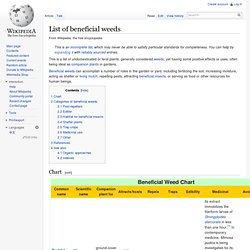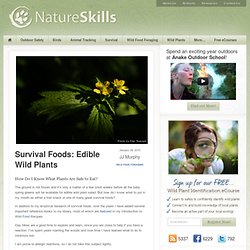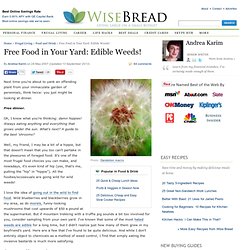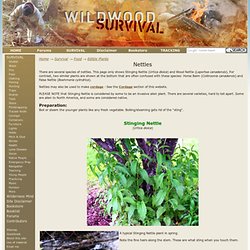

List of beneficial weeds. This is a list of undomesticated or feral plants, generally considered weeds, yet having some positive effects or uses, often being ideal as companion plants in gardens.

Beneficial weeds can accomplish a number of roles in the garden or yard, including fertilizing the soil, increasing moisture, acting as shelter or living mulch, repelling pests, attracting beneficial insects, or serving as food or other resources for human beings. Chart[edit] Categories of beneficial weeds[edit] Pest-repellent[edit] Neem -- repels leaf eating insects Edible[edit] Habitat for beneficial insects[edit] Shelter plants[edit] Normal grass can be used as ground cover, especially in nitrogenous soils. Trap crops[edit] Trap crops draw potential pests away from the actual crop intended for cultivation. Cowpea -- attracts ladybird beetle, so planting around cotton fields protects them from sucking insects.
Medicinal use[edit] Rumex -- Dock. Other[edit] Nightshade -- breaks up hardpan, allowing roots to grow deeper Indexes[edit] Edible Wild Plants. Photo by Filip Tkaczyk How Do I Know What Plants Are Safe to Eat?

The ground is not frozen and it’s only a matter of a few short weeks before all the baby spring greens will be available for edible wild plant salad. But how do I know what to put in my mouth as either a trail snack or one of many great survival foods? In addition to my empirical research of survival foods, over the years I have added several important reference books to my library, most of which are featured in my Introduction to Wild Food Recipes.
Day hikes are a good time to explore and learn, since you are close to help if you have a reaction. I am prone to allergic reactions, so I do not take this subject lightly. There are a few steps you can take when exploring the plant world for survival foods that will guide you in this discovery process. Understand the basic parts of an edible wild plant – root, stem, leaves, buds, flowers, fruit and seed. Study the plant. Do you have a reaction to the plant when you touch it? Wild Yards are Best. Free Food in Your Yard: Edible Weeds! Popular in Food & Drink Next time you're about to yank an offending plant from your immaculate garden of perennials, think twice: you just might be looking at dinner.

Free dinner. Oh, I know what you're thinking: damn hippies! Always eating anything and everything that grows under the sun. What's next? Well, my friend, I may be a bit of a hippie, but that doesn't mean that you too can't partake in the pleasures of foraged food. I love the idea of going out in the wild to find food. Broadleaf Plantain (Plantago major) Fiddleheads. Agave Root. Jerusalem Artichoke. Wild Leeks. Garlic Mustard. Gooseberries. Nettles. There are several species of nettles.

This page only shows Stinging Nettle (Urtica dioica) and Wood Nettle (Laportea canadensis). For contrast, two similar plants are shown at the bottom that are often confused with these species: Horse Balm (Collinsonia canadensis) and False Nettle (Boehmeria cylindrica). Nettles may also be used to make cordage - See the Cordage section of this website. PLEASE NOTE that Stinging Nettle is considered by some to be an invasive alien plant. There are several varieties, hard to tell apart. Preparation: Boil or steam the younger plants like any fresh vegetable. Blueberry. Indian Cucumber Root. Mayapple. Trout Lily. Wild Carrot.
Eat Weeds. Wild Garlic.